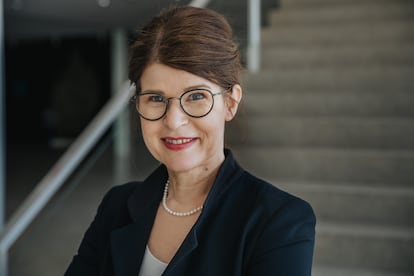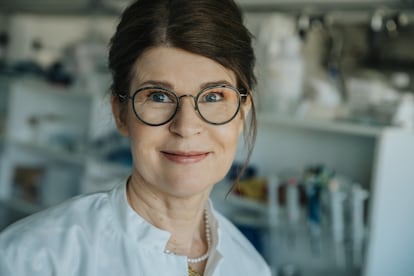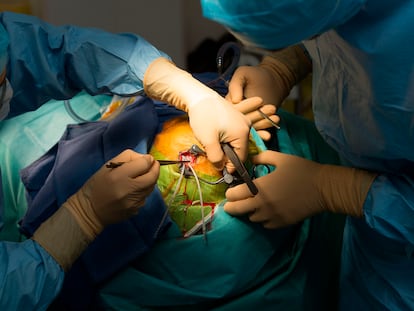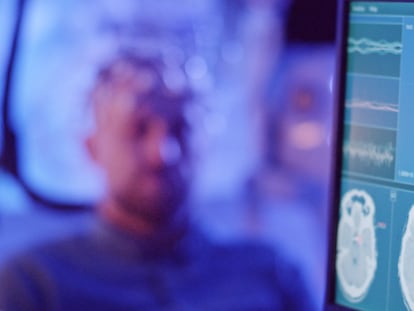Katrin Amunts, neuroscientist: ‘Our brains are different from each other at all levels’
The Human Brain Project brain atlas, recently completed after a decade, is one of the biggest scientific challenges funded by the European Union

For Katrin Amunts, a specialist in brain mapping and one of the most relevant neuroscientists of our time, “the brain is the most exciting and complex system that can be studied.” As the professor of the Cécile and Oskar Vogt Institute for Brain Research at the University of Düsseldorf and director of the Institute of Neuroscience and Medicine at the Jülich Research Center explains to EL PAÍS by videoconference, the brain’s complexity lies in its organization on multiple spatial and temporal scales: from the molecular level to the large cognitive systems that allow us to speak or remember; from the milliseconds in which its cells react to the changes it undergoes throughout our lives.
Since 2016, Amunts has also been the scientific director of the monumental Human Brain Project (HBP), one of the biggest scientific challenges ever funded by the European Union, which concluded last September after a decade of work. Within its framework, supercomputers have been used to create virtual models capable of simulating brain activity to improve the treatment of epilepsy, neurodegenerative diseases, schizophrenia and blindness. A fusion between neuroscience and technology in which 155 institutions from 19 countries have collaborated and which has resulted in more than 3,000 scientific publications, advances in artificial intelligence, the most detailed three-dimensional digital atlas of this organ and a digital research infrastructure called EBRAINS, which will continue to be available to all researchers around the world.
Question. Has the HBP fulfilled its purpose?
Answer. The HBP has sought to contribute to a deeper understanding of the human brain with ICT (information and communication technology) based research and to transfer it to medicine, new technologies and computer science. We have done this through EBRAINS, which consists of numerous tools, such as the brain atlas, and has thousands of different data from our brains and those of other animals. It allows us to develop simulations at the molecular, cellular, neural network or whole brain level and to run analyses on supercomputers or neuromorphic computing devices.
Q. How do you model something that changes from birth to death?
A. We are not looking to model the whole brain in its complexity, a model is always something specific. We have a very concrete question in mind that we then model and simulate digitally.
Q. How do the brain atlas and The Virtual Brain work?
A. The atlas is like Google Maps, but for the brain. There are very different maps, on molecular or cellular composition, on neuronal connectivity... and we can combine them and go from micro to macro. The HBP atlas contains more than 200 microstructurally defined areas, more than any other atlas in the world. It is very precise, it captures the variations of brain areas between subjects, the so-called inter-subject variability, which is essential for treating patients. The Virtual Brain is a neuroinformatics platform that allows the development of personalized digital models for clinical purposes. For example, to plan epilepsy surgery or to improve the location of electrodes that allow deep brain stimulation in Parkinson’s disease when drugs are no longer effective.
Q. What other clinical applications have been developed?
A. Researchers performing molecular-level simulations are identifying more potent drugs for diseases such as neurodegenerative diseases. There are also advances in the field of consciousness disorders, such as coma patients. Knowing how deep the coma is has implications for therapy and for relatives. Marcelo Massimini and Steve Laurie, researchers from Milan and Liège, have developed an index for estimating the complexity of brain activity that allows us to grade this depth and helps physicians to develop a strategy for waking up such patients.
Q. Are our brains very different from each other?
A. Yes, at all levels. From the microscopic, to the cellular, to the brain as a whole. That’s why our atlas is based on microstructural maps of 10 different human brains, five male and five female. We provide probabilistic maps; they show the probability with which you can find a certain brain area in a certain position by combining neuroimaging or physiological data of a patient with the atlas information.
Q. Do women’s and men’s brains differ?
A. The similarities are greater, but there are gender-specific differences. At the functional level, there are differences in language or spatial navigation. At the structural level, there are differences in the visual cortex or in areas related to language. But because we have such wide inter-subject variability, it is difficult to understand the functional significance of a subtle structural difference. For example, measures of intelligence do not differ between women and men, there could be different strategies that evolution has chosen to achieve a certain goal. They are different, but that is not necessarily related to an advantage or a disadvantage.

Q. To get to your position, have you faced different challenges than those a man would have faced?
A. It is difficult to say. There is an imbalance between men and women in management positions and one of my objectives from the beginning was to change that situation. For such a big project we have possibilities, and we invited external companies to advise us. Thus, we have developed awareness-raising activities and gender-balanced calls or conferences. As a researcher, I had a particular interest in supporting gender balance because, besides a social dimension — who leads, who is the visible face — it also has a scientific dimension and direct consequences for medicine. Many therapies have been tested only in male cohorts, but female bodies react somewhat differently. We have achieved a lot, but we cannot yet be satisfied.
Q. If you had to highlight just one thing you didn’t know 10 years ago, what would it be?
A. I am interested in how the brain is segregated into areas, and in these ten years we have learned that it is much more fragmented than we assumed. Also, that it is parceled out according to hierarchical principles, it is not just a mosaic. One example is Broca’s area, which is responsible for language. We have known about it for 160 years and it was always assumed that it was subdivided into two areas, 44 and 45. Now we know that the whole region has more than a dozen areas and that there is a whole bunch above it, and a whole bunch below it.
Q. What would you like to achieve in the next decade?
A. A major challenge is to understand the relationships between the different levels of brain organization. Even today, a lot of research is still focused on one aspect of that organization, but it is necessary to bridge these different scales. This is now increasingly feasible with EBRAINS. Without digitalization we cannot address this complexity; we need supercomputers, morphic computers and quantum computers. I see a lot of progress and synergies between neuroscience, computer science and technology.
Q. What have we learned about how neurons and brain tissue recover or renew themselves?
A. There are different ways to restore function. New neurons can be formed, but in the human brain this is only demonstrated in some regions, such as the hippocampus. It is also difficult to demonstrate, to be honest. And we should not image that they are renewed like muscle or skin cells; neurons have some capacity to proliferate and mature, but it’s not clear whether that can restore function or make it better. We do know that it is possible to increase the efficacy of synaptic transmission between neurons. We also know that the brain has many parallel ways of connecting brain regions to each other, it is very redundant. This helps us to solve the same question through other neural networks. Thus, restoring functions and capacities is the achievement of the brain as an organ, as a system.
Q. So, does the brain have secondary or tertiary engines, in case the primary one fails?
A. Redundancy refers to connectivity. There are 86 billion neurons and each one has ten thousand synapses, at least in the cortex. Then we have two or three million kilometres of axons and dendrites. It is not a single cell that projects to another cell that performs a function, there are always groups and clusters of cells. And these groups form networks. We perceive connectivity also as a hierarchical system. We have networks of networks of networks. There is just a lot of flexibility.
Q. Could you give an example?
A. In an experiment, I asked subjects to name different flowers every two seconds. There are different ways of doing this: by saying the first thing that comes to mind, alphabetically, or by going to the garden and counting the ones you see. These are different strategies of answering to a simple semantic question that use different networks to fulfil the same cognitive function. It also applies when we come to gender differences and spatial navigation. Women orient themselves more by landmarks: “when you see the yellow house, turn right until you get to the bakery”; while men more often follow a geographical orientation: “go east, then turn right.” It is not a question of whether any of those strategies is better or not, both can be successful.
Q. This would also apply in case of a stroke, correct?
A. Yes, after a stroke, rehabilitation can try to activate the tissue in the penumbra zone (that one peripheral to the stroke area) to take over some responsibilities, and this can be learned. Colleagues in Lausanne have developed a stimulation method for patients after paralysis due to a complete transverse lesion of the spinal cord. They manage to stimulate the spinal cord under the injury so that the muscles react. It is a type of rehabilitation we had never imagined.
Q. Does the patient do it through a device?
A. Yes, but it is also a learning process, like when people who have lost a leg learn to use a prosthesis. If it works well, they feel it as part of their body. It’s more than having a device, it’s regaining movement. It’s high-tech medicine, there are very few centers capable of doing such difficult surgeries and obviously it won’t work on every injury, but it’s something we didn’t even dream of when the HBP started.
Another example comes from colleagues in Amsterdam who are developing visual prostheses for patients with retinal lesions. They have developed electrode arrays (devices with multiple microelectrodes) that are implanted in the visual cortex, stimulating it in such a way that contours of people or figures are perceived again. The first human trials have been successful. It would be a breakthrough at the intersection of neuroscience and new medical and computational technologies. I find it extremely exciting to see it. The HBP was precisely the place where such things happen, an environment for research that crosses the boundary between disciplines.
Q. How does the brain shape our personality?
A. Inter-subject variability has been perceived in the past as some kind of noise that we must eliminate to come to “the description” of the brain. Of course, this is only half of the truth. There is MRI research studying how the activation of neural networks varies depending on the personality profile. However, it is not yet understood how personality traits break down at the cellular level. Only in diseases, such as a very rare one called Urbach-Wiethe. These are people who have no empathy and have a calcification of the amygdala. Here we have a clinical finding and a relationship, but for other personality traits, it’s widely unexplored. And we are complex systems; we are surrounded by many other human beings, and that shapes us.
Q. As research on other animal’s brains advances, should we feel privileged or humbler?
A. It depends on personality, I guess. I would feel humbler, honestly. We see striking similarities and that evolution just went in different directions. We are privileged because we can shape our environment, but this privilege comes with a responsibility. Knowing the brains of apes, mammals or birds helps us to understand our own, but also to appreciate other species. We have very limited knowledge compared to the enormous number of existing ones; it is like a drop in the ocean. We don’t even know much about cows or pigs, animals that surround us. That should change to better appreciate ecology, too.
Q. Could we end up reading people’s minds?
A. It is already possible to predict some brain activities in experimental setups. Deep learning is a very powerful method to explain patterns. The question is how far it goes, and what are the limits of understanding and the effort needed to obtain such information. But perhaps we can already achieve more information by analyzing the readouts of our mobile phones, following the pattern of movement and usage behavior of smartphones. We are facing significant and complex questions. By the way, in the HBP we had a subproject on ethics and philosophy from the very beginning. It has not been an easy collaboration, they are people with a different angle, but very fruitful and necessary.
Q. Some argue that there is an urgent need to regulate on neurorights.
A. Regulation is handled differently from one European country to another, sometimes even from one university to another. We already have a rich body of regulation and ethics committees. Progress in research is in the interest of society and Europe. Although there is a very competitive situation globally, the HBP has pioneered digital neuroscience like nowhere else in the world. We can be very optimistic about the next decade.
Sign up for our weekly newsletter to get more English-language news coverage from EL PAÍS USA Edition
Tu suscripción se está usando en otro dispositivo
¿Quieres añadir otro usuario a tu suscripción?
Si continúas leyendo en este dispositivo, no se podrá leer en el otro.
FlechaTu suscripción se está usando en otro dispositivo y solo puedes acceder a EL PAÍS desde un dispositivo a la vez.
Si quieres compartir tu cuenta, cambia tu suscripción a la modalidad Premium, así podrás añadir otro usuario. Cada uno accederá con su propia cuenta de email, lo que os permitirá personalizar vuestra experiencia en EL PAÍS.
¿Tienes una suscripción de empresa? Accede aquí para contratar más cuentas.
En el caso de no saber quién está usando tu cuenta, te recomendamos cambiar tu contraseña aquí.
Si decides continuar compartiendo tu cuenta, este mensaje se mostrará en tu dispositivo y en el de la otra persona que está usando tu cuenta de forma indefinida, afectando a tu experiencia de lectura. Puedes consultar aquí los términos y condiciones de la suscripción digital.
More information
Últimas noticias
ICE raids trigger school absenteeism and traumatize children: ‘They have been forced to leave their childhood behind’
The life of a delivery driver in China: ‘Many people don’t know how an order can arrive at their home in just one day’
Maude Apatow, from acting in ‘Euphoria’ to directing: ‘There are many films that you can tell weren’t written by someone young’
Families demand repatriation of bodies of Colombians who died in Ukraine: ‘This war is a slaughterhouse for foreigners’
Most viewed
- Christian Louboutin: ‘Young people don’t want to be like their parents. And if their parents wear sneakers, they’re going to look for something else’
- US sanctions against jailed cartel leader ‘El Marro’ highlight Mexico’s lack of control over its prisons
- Cartels in Mexico take a leap forward with narco-drones: ‘It is criminal groups that are leading the innovation race’
- Liset Menéndez de la Prida, neuroscientist: ‘It’s not normal to constantly seek pleasure; it’s important to be bored, to be calm’
- ‘El Limones’ and the growing union disguise of Mexican organized crime











































